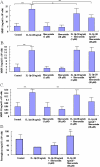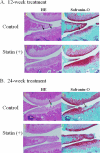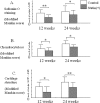Statin prevents chondrocyte aging and degeneration of articular cartilage in osteoarthritis (OA)
- PMID: 21098883
- PMCID: PMC3034187
- DOI: 10.18632/aging.100213
Statin prevents chondrocyte aging and degeneration of articular cartilage in osteoarthritis (OA)
Abstract
Recent reports have shown that statin (HMG-CoA reductase inhibitors) may have the potential to inhibit inflammatory arthritis. More recently, the idea that chondrocyte aging is closely associated with the progression of cartilage degeneration has been promulgated. Here, we demonstrate the potential of statin as protective agents against chondrocyte aging and degeneration of articular cartilage during the progression of osteoarthritis (OA), both in vitro and in vivo. The OA-related catabolic factor, IL-1β induced marked downregulation of cellular activity, expression of a senescent biomarker, specific senescence-associated β-galactosidase activity and shortening of the cellular lifespan in chondrocytes. In contrast, treatment with statin inhibited the IL-1β-induced production of cartilage matrix degrading .enzymes (metalloprotease-1 and -13) and cellular senescence in of chondrocytes in vitro. In addition, this statin accelerated the production of cartilage matrix proteoglycan in chondrocytes. The in vivo study was performed on the STR/OrtCrlj mouse, an experimental model which spontaneously develops an osteoarthritic process. In this mouse model, treatment with statin significantly reduced the degeneration of articular cartilage, while the control knee joints showed progressive cartilage degeneration over time. These findings suggest that statin may have the potential to prevent the catabolic stress-induced chondrocyte disability and aging observed in articular cartilage. Our results indicate that statin are potential therapeutic agents for protection of articular cartilage against the progression of OA.
Conflict of interest statement
The authors of this manuscript have no conflict of interests to declare.
Figures




Similar articles
-
Water-soluble C60 fullerene prevents degeneration of articular cartilage in osteoarthritis via down-regulation of chondrocyte catabolic activity and inhibition of cartilage degeneration during disease development.Arthritis Rheum. 2007 Oct;56(10):3307-18. doi: 10.1002/art.22917. Arthritis Rheum. 2007. PMID: 17907184
-
Potential involvement of oxidative stress in cartilage senescence and development of osteoarthritis: oxidative stress induces chondrocyte telomere instability and downregulation of chondrocyte function.Arthritis Res Ther. 2005;7(2):R380-91. doi: 10.1186/ar1499. Epub 2005 Jan 26. Arthritis Res Ther. 2005. PMID: 15743486 Free PMC article.
-
Overexpression of Sirtuin 6 suppresses cellular senescence and NF-κB mediated inflammatory responses in osteoarthritis development.Sci Rep. 2015 Dec 7;5:17602. doi: 10.1038/srep17602. Sci Rep. 2015. PMID: 26639398 Free PMC article.
-
Aging, articular cartilage chondrocyte senescence and osteoarthritis.Biogerontology. 2002;3(5):257-64. doi: 10.1023/a:1020185404126. Biogerontology. 2002. PMID: 12237562 Review.
-
Molecular regulation of articular chondrocyte function and its significance in osteoarthritis.Histol Histopathol. 2011 Mar;26(3):377-94. doi: 10.14670/HH-26.377. Histol Histopathol. 2011. PMID: 21210351 Review.
Cited by
-
Simvastatin Inhibits IL-1β-Induced Apoptosis and Extracellular Matrix Degradation by Suppressing the NF-kB and MAPK Pathways in Nucleus Pulposus Cells.Inflammation. 2017 Jun;40(3):725-734. doi: 10.1007/s10753-017-0516-6. Inflammation. 2017. PMID: 28188410
-
Statins and adhesion molecules: a review of a novel pleiotropic property of statins.Immunol Res. 2025 Jun 17;73(1):97. doi: 10.1007/s12026-025-09653-2. Immunol Res. 2025. PMID: 40526251 Review.
-
Modeling craniofacial and skeletal congenital birth defects to advance therapies.Hum Mol Genet. 2016 Oct 1;25(R2):R86-R93. doi: 10.1093/hmg/ddw171. Epub 2016 Jun 26. Hum Mol Genet. 2016. PMID: 27346519 Free PMC article. Review.
-
Statin-Induced Geranylgeranyl Pyrophosphate Depletion Promotes Ferroptosis-Related Senescence in Adipose Tissue.Nutrients. 2022 Oct 18;14(20):4365. doi: 10.3390/nu14204365. Nutrients. 2022. PMID: 36297049 Free PMC article.
-
Current Care and Investigational Therapies in Achondroplasia.Curr Osteoporos Rep. 2017 Apr;15(2):53-60. doi: 10.1007/s11914-017-0347-2. Curr Osteoporos Rep. 2017. PMID: 28224446 Free PMC article. Review.
References
-
- Smith DA, Galin I. Statin therapy for native and peri-interventional coronary heart disease. Curr Mol Med. 2006;6:589–602. - PubMed
-
- Laufs U, La Fata V, Plutzky J, Liao JK. Upregulation of endothelial nitric oxide synthase by HMG CoA reductase inhibitors. Circulation. 1998;97:1129–1135. - PubMed
-
- Pleiner J, Schaller G, Mittermayer F, Zorn S, Marsik C, Polterauer S, Kapiotis S, Wolzt M. Simvastatin prevents vascular hyporeactivity during inflammation. Circulation. 2004;110:3349–3354. - PubMed
-
- Stoll G, Bendszus M. Inflammation and atherosclerosis: novel insights into plaque formation and destabilization. Stroke. 2006;37:1923–1932. - PubMed
Publication types
MeSH terms
Substances
LinkOut - more resources
Full Text Sources
Other Literature Sources
Medical

